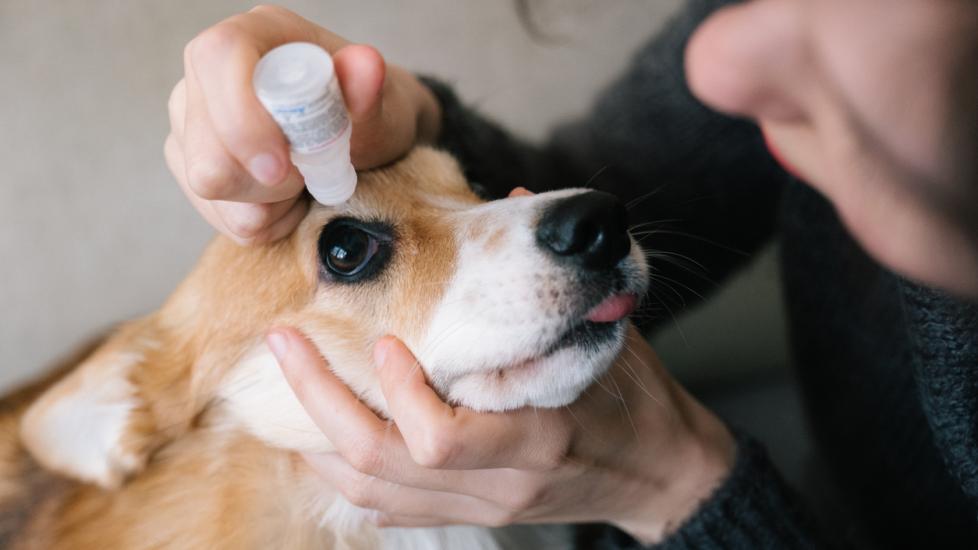Title: Understanding and Managing Dry Eye Syndrome in Your Furry Friend
Introduction:
In the world of our canine companions, dry eye syndrome (also known as keratoconjunctivitis sicca or KCS) is a condition that affects dogs more commonly than humans. It occurs when there’s an insufficient production of tears, leading to irritation, inflammation, and potential damage to your dog’s eyes. As pet owners, it’s crucial to recognize the signs of this condition and understand how to manage it effectively. This article aims to provide you with comprehensive insights into dry eye syndrome in dogs, including its causes, symptoms, diagnosis, treatment options, and preventive measures.
Causes of Dry Eye Syndrome in Dogs:
The exact cause of dry eye syndrome remains somewhat elusive, but several factors have been identified that may contribute to its development. These include:
1. Immune System Dysfunction – Sometimes, the immune system mistakenly attacks the tear-producing glands, reducing their ability to secrete adequate moisture for the eyes.
2. Hypothyroidism – An underactive thyroid gland can lead to various health issues, including dry eyes due to hormonal imbalances affecting tear production.
3. Inflammation – Chronic inflammation within the body can extend to the lacrimal glands, resulting in decreased tear production.
4. Hereditary Factors – Some breeds are predisposed to developing KCS due to genetic vulnerabilities. Breeds like Shar Pei, Lhasa Apsos, West Highland White Terriers, Cocker Spaniels, and Schnauzers seem particularly susceptible.
5. Medications – Certain drugs, such as those used to treat allergies or seizures, might trigger dry eye syndrome as a side effect.
Symptoms of Dry Eye Syndrome in Dogs:
Recognizing the early signs of dry eye syndrome is key to prompt intervention. Watch out for these telltale indications:
1. Excessive Blinking or Pawing at Eyes
2. Redness or Discoloration Around the Eyes
3. Stringy Tears That May Be Yellowish in Color
4. Scratching or Rubbing of the Face Against Furniture or Other Objects
5. Squinting or Closing One or Both Eyes More Often Than Usual
6. Cloudiness or Decreased Vision
7. Painful or Light Sensitivity
Diagnosis and Treatment:
If you suspect your dog has developed dry eye syndrome, it’s essential to schedule an appointment with a veterinarian immediately. The vet will likely perform a thorough examination of the eyes, possibly using tests such as Schirmer tear test strips to measure tear production levels. If diagnosed with KCS, treatments typically involve:
1. Artificial Tear Supplements – To increase lubrication and hydration of the eyes.
2. Prescription Medication – Corticosteroids or immunosuppressants may be prescribed to reduce inflammation and control autoimmune responses.
3. Oral Medications – Hormonal therapy or supplements to stimulate tear production.
4. Environmental Modifications – Providing a humid environment through use of humidifiers or placing bowls of water around the house.
5. Regular Eye Care – Daily cleaning and application of medications as directed by the vet.
Prevention Strategies:
While some cases of dry eye syndrome cannot be prevented entirely, taking proactive steps can help maintain healthy tear production and support overall eye health:
1. Regular Checkups – Schedule routine veterinary visits to monitor your dog’s health and address any emerging concerns promptly.
2. Dietary Considerations – Feeding a high-quality diet rich in omega-3 fatty acids can promote good skin and coat health, which can indirectly support healthy tear production.
3. Avoidance of Triggers – Keep your dog away from allergens and irritants that could exacerbate dry eye symptoms.
4. Hydration Tips – Encourage plenty of fresh water intake to ensure optimal hydration throughout the body.
5. Regular Exercise – Engage in regular physical activity with your dog to boost circulation and overall well-being.
Conclusion:
Dry eye syndrome in dogs requires attentive care and management. By recognizing the symptoms, understanding the underlying causes, and following recommended treatments and prevention strategies, you can help ensure your furry friend maintains bright, comfortable eyes for many years to come. Remember, every dog is unique, so what works best may vary. Always consult with a qualified veterinarian for personalized advice tailored to your dog’s needs.
